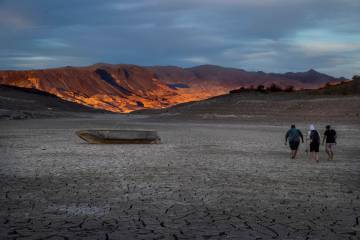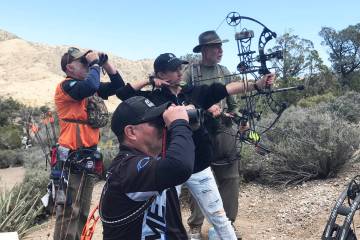Emergency notification device essential
Do something long enough and sooner or later you will find yourself on the bad end of an unplanned situation. Proof of that can be seen in the missing digits, or parts thereof, on the hands of your friends or acquaintances who spend a lifetime working with power saws and lumber. All it takes is one small mistake, a simple miscalculation or a momentary lapse of judgment and your circumstance can be changed dramatically.
The same is true for those of us who spend much of our lives in the outdoors.
Consider the story of James Glanton, 34, and Christina McIntee, 25. They are the northwest Nevada couple who took their two children, along with a niece and a nephew, into the mountains near Lovelock to play in the snow and became stranded when their Jeep overturned. Further complicating their situation were nighttime temperatures that plummeted well below zero.
Nearly two years ago, a friend and I found ourselves stranded on an island in the Virgin Basin of Lake Mead after running his boat aground in the dark of night.
No one was hurt in either of these circumstances, but what if that had not been the case? In both instances, we knew exactly where we were, but those who came looking for us had only a general idea of where to conduct their search. Luckily, rescuers were able to use a cellphone signal to help find the Glanton-McIntee party, and I could hit a cellphone tower with enough bars to call for assistance.
Though there are untold circumstances when cellphones have helped rescuers fulfill their missions, there is no guarantee they will always hit a tower. If that happens, then what?
Following the Glanton-McIntee rescue, one of my readers asked me to look into products that will help facilitate a rescue operation when needed. So I kept an eye out while walking the aisles at the Shooting, Hunting and Outdoor Trade Show this month at the Sands Convention Center.
It was there I ran into Michael Heffron, president and CEO of DeLorme, the company famous for its road atlas and gazetteer. He was at the show to talk about the inReach SE, a satellite communication device that would appear to make a standard GPS unit somewhat obsolete.
Heffron said the inReach SE has been on the market for two years, but its unique capabilities are still worth noting, especially if you are thinking of purchasing an emergency notification device. This product has two-way communication capability that uses the iridium satellites and allows you to send text messages or emails using your personal email address. It also comes with built-in GPS capability, so any time a message is sent, the coordinates of the originating location are included. And to top things off, the product also comes with SOS capability.
“If you get into trouble, all you have to do is trigger that SOS,” Heffron said. “That goes to a remote monitoring service that is monitored 24 hours a day, seven days a week. When they get that message, they know who sent it, they know where it was sent from, and they can start communicating with you. They can ask you what’s going on. What’s the nature of the emergency? What type of services do you need?”
Armed with that information, GEOS, the third-party monitoring service based out of Austin, Texas, can contact emergency services anywhere in the world. And “this device will work anywhere in the world,” Heffron said.
For the outdoor enthusiast with significant others back at home, the inReach user can set his device to periodically share his GPS coordinates with them so they can track his movements from home. The device also can be paired with your cellphone.
The inReach SE retails for $299, and then you will need to subscribe to a service. You have the choice of an annual subscription or activating the device month by month.
Freelance writer Doug Nielsen is a conservation educator for the Nevada Department of Wildlife. His “In the Outdoors” column, published Thursday in the Las Vegas Review-Journal, is not affiliated with or endorsed by the NDOW. Any opinions he states in his column are his own. He can be reached at intheoutdoorslv@gmail.com.






















